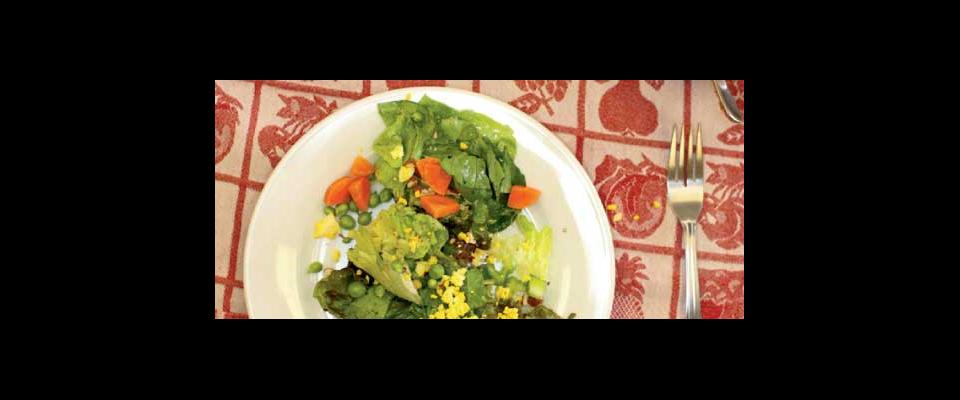How to get kids to eat their vegetables.
Elementary students in the Berkeley Unified School District have some strange eating habits. No Pop-Tarts, no cheese-flavored Doritos, not even those little doughnuts with the powdered sugar. They prefer weeditos—their own version of burritos. At recess, the kids run to the garden—all 16 of the schools in the district have one—tear themselves off a big chard leaf, fill it with a handful of edible flowers and a plump radish, roll it up, and chow down. Sometimes they go back for seconds and thirds.
Then they go home and ask for spinach.
It seems a little too good to be true. But according to a study conducted by Berkeley’s Dr. Robert C. and Veronica Atkins Center for Weight and Health, the district’s students are discovering vegetables in a big way. “We have moms coming in asking ‘What is jicama? My kid loves it and wants to eat it at home,'” says Suzanne Rauzon, director of the study.
In 2006, the center began a comprehensive examination of the children’s eating habits and behaviors. They wanted to know whether the Berkeley district’s School Lunch Initiative, one of the most ambitious programs in the country, would really change the way kids eat. And if it did, how would it affect students’ academic performance and levels of fitness?
It all started in 1995, when Berkeley restaurateur Alice Waters ’67 founded the Edible Schoolyard (soon after, funded by her Chez Panisse Foundation), a one-acre organic garden and kitchen classroom, at Martin Luther King Jr. Middle School. In the years to follow, other schools in the district planted gardens paid for with grant money from the Network for a Healthy California, a consortium of local, state, and national organizations working to improve the health of low-income families through increased fruit and vegetable consumption and exercise. Besides gardening, the district added nutrition and cooking classes.
Then in 2004, the Chez Panisse Foundation and the Center for Ecoliteracy along with educators, parents, and nutrition experts decided to revamp the district’s cafeteria lunches. They hired celebrated school chef Ann Cooper as Director of Nutrition Services, and she in turn outlawed the serving of processed foods and went to an everything-from-scratch kitchen. Produce was purchased from local farms, dairy products from local creameries, and breads and pizza crusts from local bakeries—organic whenever possible.
“I think the Berkeley model is a role model for everyone around the country,” says Kate Adamick, of the Orfalea Foundation’s S’Cool Initiative, a nonprofit working with Santa Barbara County’s school districts to start similar programs.
The thought was that if kids themselves cultivated and cooked nutritious food, they might actually eat it. And if the cafeteria served lots of fresh fruit, vegetables, and whole grains, students would learn by example. It was a grand experiment. But would it work?
That’s where the Center for Weight and Health came in. Researchers followed 267 students from four different elementary schools—two with garden, cooking, and nutrition programs that were highly developed, and two with a less developed curriculum that relied mostly on parent volunteers. Students were also asked to submit a food log and to answer a questionnaire about their eating habits. The center is reporting its preliminary findings, although the final results won’t be out until 2010. For now, researchers are not releasing the names of the schools and are waiting for the results of the academic and fitness evaluations for this school year.
So far, “the nutrition knowledge of students from all four schools improved over a year’s time,” says Rauzon. But the kids participating in the advanced programs showed a significantly greater preference for leafy green vegetables than the students in the less-developed programs. They also scored higher on knowledge of nutrition, food, and environment and ate more nutritious foods and less junk, according to the study.
Pat Crawford, director of the center and an adjunct professor in public health and nutrition at Berkeley, is not surprised. “As one would expect, the impact is greater when the exposure is greater,” she says. “The more ways you can support health changes, the more the children will adopt the behavior. There’s nothing wrong with just having a salad bar or just having a garden. But what is resoundingly clear is that when you combine all these disciplines, you get the highest outcome.”
Researchers took the study a step further. Anna Martin, a program specialist with the center, began documenting exactly what the students ate over the course of 133 lunches. She photographed each student’s meal, whether it was a sack lunch brought from home or a lunch from the cafeteria, before the children started eating—but after they finished their trading. The lunch hour at elementary schools resembles something akin to the New York Stock Exchange. Kids trade everything from sandwiches and protein bars to cookies and apples. Then after they ate their lunches, Martin photographed what was left on trays and in lunch boxes. “At all four schools, the kids who got the cafeteria lunch ate three times the amount of vegetables as the ones who brought their lunches from home,” Martin says.
The school lunches are accompanied by a help-yourself salad bar. At one time the cafeteria kids would have made a beeline for the croutons, cheese, and ranch dressing, but Martin was amazed to find them also loading their plates with leafy greens, carrots, celery, and various other vegetables.
For many, that finding was key. The USDA recommends that everyone get five to nine servings of fruit and vegetables a day. “It’s not difficult to get kids to eat fruit,” says Martin. “But vegetables are a different story.”
According to Juliet Sims, program coordinator for the Prevention Institute, an Oakland nonprofit dedicated to health and social issues, 30 to 50 percent of a child’s daily diet is consumed during the school lunch period. So when done right, it is a meal that can play a significant role in reaching the daily produce quota.
At least some minimal work in the garden and sporadic nutrition instruction, in addition to school lunches rich in fresh, seasonal vegetables, went a long way to upping the students’ produce consumption, according to the study. Students from all four schools listed chard, spinach, and kale among their favorite foods on their questionnaires; claims that were backed up by their parents. “The salad bar is the most popular food sold in the high school,” says Eric Weaver, a Berkeley parent who remembers when it was junk food or nothing.
Michele Lawrence, who retired as superintendent from Berkeley Unified last year and was one of the architects of the School Lunch Initiative, says she is heartened by the progress. “This is really a national health issue and it’s one that educators should be taking a lead on,” she says. “I think it’s possible for every California school to do what Berkeley has done.”
Crawford says it’s the best way to protect future generations from chronic disease. “Only 1 percent to 2 percent of children in the United States meet the recommended dietary guidelines,” she says, adding that about one-third of the nation’s youth is overweight. “The Center for Disease Control and Prevention predicts that one out of three children will have diabetes at some point in his or her life. We’re already seeing children with higher blood pressure and higher lipids.”
But if the results of the study are as promising in 2010 as they are now, and if Berkeley’s model is replicated across the country, Crawford is optimistic. “It’s just powerful to see it happen,” she says. “It gives you a lot of hope that this is all possible.”





















